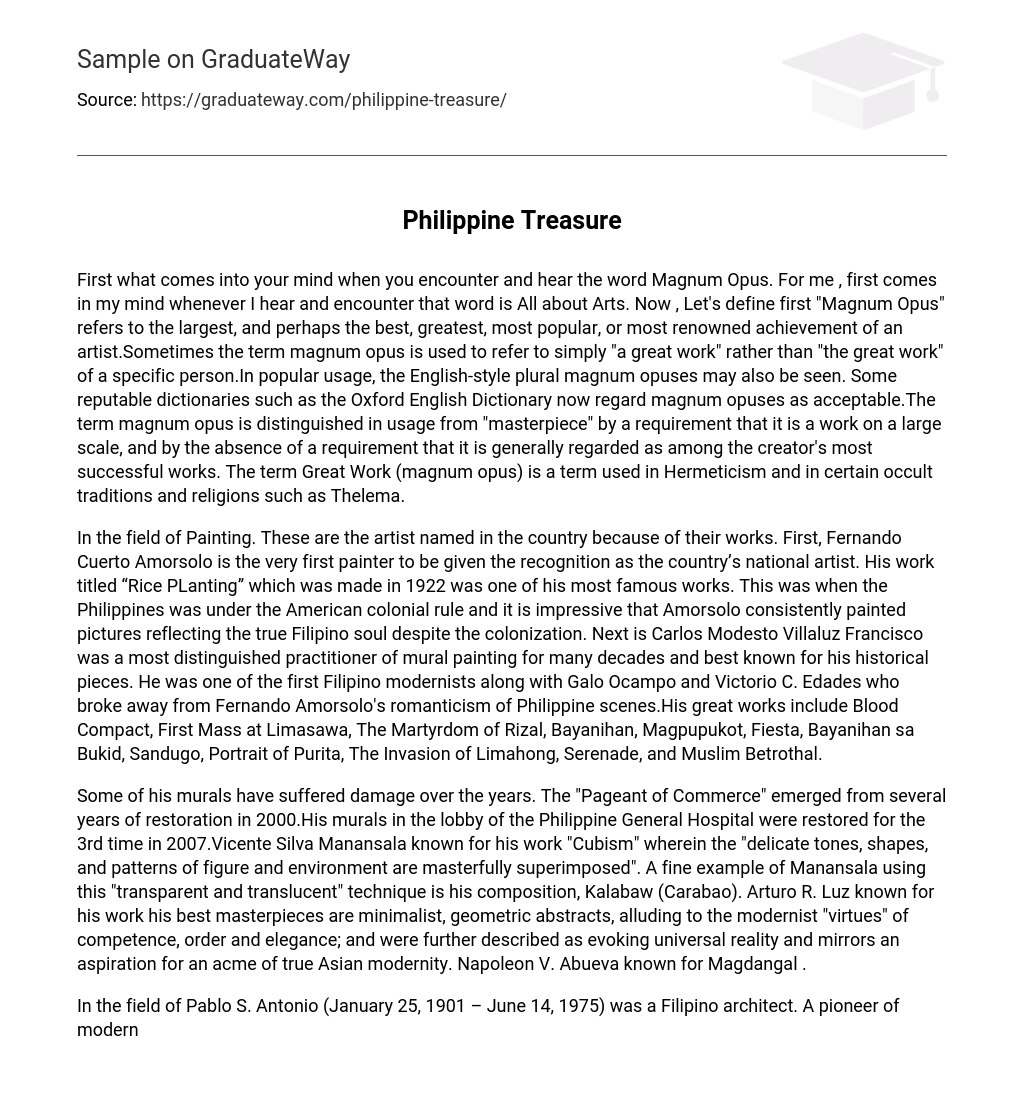When encountering and hearing the phrase Magnum Opus, the first thing that comes to mind for me is the world of Arts. Magnum Opus refers to the largest and perhaps the best, greatest, most popular, or most renowned achievement of an artist. It can also simply refer to a great work rather than a specific person’s great work. The English-style plural magnum opuses can also be used in popular usage. Reputable dictionaries like the Oxford English Dictionary now accept this usage. The term Magnum Opus is distinct from “masterpiece” in that it implies a work on a large scale and does not require it to be among the creator’s most successful works. In Hermeticism and certain occult traditions and religions like Thelema, there is a concept of the Great Work (Magnum Opus).
The field of Painting in the country has produced several renowned artists. One such artist is Fernando Cuerto Amorsolo, who became the first painter to be recognized as the national artist. His notable work, “Rice Planting,” was created in 1922 and remains one of his most famous pieces. It is remarkable that Amorsolo consistently depicted the true Filipino essence in his paintings, even during the period of American colonial rule.
Another notable artist is Carlos Modesto Villaluz Francisco, who excelled in mural painting for many decades and was renowned for his historical pieces. Alongside Galo Ocampo and Victorio C. Edades, Francisco was among the first Filipino modernists to depart from Fernando Amorsolo’s romanticized depictions of Philippine scenes. Some of his significant works include Blood Compact, First Mass at Limasawa, The Martyrdom of Rizal, Bayanihan, Magpupukot, Fiesta, Bayanihan sa Bukid, Sandugo, Portrait of Purita, The Invasion of Limahong, Serenade, and Muslim Betrothal.
Some of Vicente Silva Manansala’s murals have experienced damage over time. The “Pageant of Commerce” underwent several years of restoration in 2000. His murals in the lobby of the Philippine General Hospital were restored for the third time in 2007. Manansala is recognized for his artistic style called “Cubism” where he skillfully overlays delicate tones, shapes, and patterns of figures and environments. One fine example of Manansala employing this technique is his composition titled Kalabaw (Carabao).
Arturo R. Luz is renowned for his minimalist, geometric abstract masterpieces that allude to the modernist ideals of competence, order, and elegance. They also mirror an aspiration for an ultimate Asian modernity, while simultaneously evoking a sense of universal reality.
Napoleon V. Abueva is known for his creation, Magdangal.
Pablo S. Antonio (January 25, 1901 – June 14, 1975) was a renowned Filipino architect and pioneer of modern Philippine architecture. He was widely considered the country’s leading modernist architect during his time. In 1976, President Ferdinand Marcos honored him with the esteemed title of National Artist of the Philippines.
Meanwhile, Leandro V. Locsin was a well-known Filipino architect, artist, and interior designer. His projects were characterized by his innovative use of concrete, floating volume, and minimalist design. Alongside his architectural work, Locsin had a profound love for collecting modern paintings and Chinese ceramics.
He was proclaimed a National Artist of the Philippines for Architecture in 1990 by the late President Corazon C. Aquino. Juan F. Nakpil (1899–1986) was a Filipino architect, teacher, and community leader. In 1973, he was named one of the National Artists for architecture and tapped as the Dean of Filipino Architects. Other artists who were also recognized in the Philippines for their works are Ildefonso P. Santos, Cesar Legaspi, Honorata “Atang” Dela Rama, Rolando S. Tinio, Salvador F. Bernal, Lamberto V. Avellana, Wilfrido Ma. Guerrero, Severino Montano, Ramon Valera, Antonio J. Molina, and Andrea O. Veneracion.
To conclude, contemplate how to integrate your comprehension of art into your everyday existence, engage in discussions with others about your sentiments towards artwork, and educate others about the approachability of art. I aspire for their creations to act as a beginning in your artistic expedition and foster your passion and appreciation for art. I have faith that you have enjoyed this journey.





